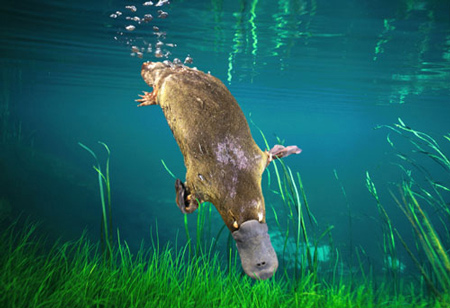Electroreception in Platypus (Ornithorhynchus anatinus)
Biology 342 Fall 2010
Author:
Emily Fong
| Home | Phylogeny | Ontogeny | Mechanism | Adaptative Value | References | Course Home |
Adaptive Value
Finding Food with Electroreception
Platypus are largely nocturnal and crepuscular, usually confining their activities to the early morning and late evening hours, but are sometimes known to be active during the day if the sky is overcast. It has long been known that platypus shut eyes, ears, and noses while diving, so electroreception has been adapted as an alternative sensory mechanism. The platypus can determine the direction of an electric source, which is generated by muscular contractions, by comparing differences in signal strength across the array of electroreceptors in the skin of its bill. As platypus are often found inhabiting turbid, opaque water , this electrodetection system is an excellent way of providing detailed information about the platypus' underwater surroundings (Barrett, 1941).
A time budget study conducted by Manger and Pettigrew examining the platypus' feeding activity found that platypus spent approximately 41.3% of their time in the water patrolling for food and foraging, indicating that the platypus is actively using the electroreceptive system in these periods (1995). In addition, they also found that this patrolling behavior increased the area coverage by threefold, in comparison to pre-patrol behavior, increasing the probability of the platypus finding food. The platypus must eat be able to locate and eat quite a bit of food each day (up to half its body mass!), and, particularly considering both the large amount of time they devote to searching for food and the added benefits their electroreceptive system provides when foraging, this is a very adaptive trait.
Platypus in Captivity
Concerns about raising platypus in captivity have been raised, particularly in light of the possible stress the enclosure’s electric water pumps could place on the animal as it tries to navigate its environment and search for food (Anderson, 1988). However, Serena and Williams conducted a study that surveyed the duration of survival of platypus living in Australian zoos and found a high survival rate among captive platypus, including those that were caught and integrated into captive collections (1993) . In addition, platypus have also been able to reproduce successfully in captivity. Much of the misconceptions attributed to platypus’ suitability for captive husbandry can be attributed to an study published by Whittington, whose results reported incredibly high rates of mortality amongst captive platypus (1991). These results, however, also categorized wild platypus that had died at zoos while under veterinary care as ones “managed in captivity,” skewing the results, and this possibly explaining the stark disparity between these results and those found by Serena and Williams.
